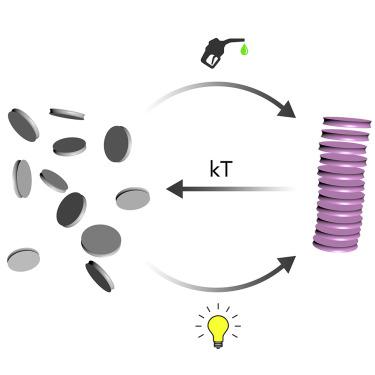Chem ( IF 23.5 ) Pub Date : 2021-01-06 , DOI: 10.1016/j.chempr.2020.11.025 Maren Weißenfels , Julius Gemen , Rafal Klajn

|
Dissipative self-assembly is ubiquitous in nature, where it gives rise to complex structures and functions such as self-healing, homeostasis, and camouflage. These phenomena are enabled by the continuous conversion of energy stored in chemical fuels, such as ATP. Over the past decade, an increasing number of synthetic chemically driven systems have been reported that mimic the features of their natural counterparts. At the same time, it has been shown that dissipative self-assembly can also be fueled by light; these optically fueled systems have been developed in parallel to the chemically fueled ones. In this perspective, we critically compare these two classes of systems. Despite the complementarity and fundamental differences between these two modes of dissipative self-assembly, our analysis reveals that multiple analogies exist between chemically and light-fueled systems. We hope that these considerations will facilitate further development of the field of dissipative self-assembly.
中文翻译:

耗散的自组装:化学物质与光能助燃
耗散性自组装在自然界中无处不在,它会导致复杂的结构和功能,例如自我修复,体内动态平衡和伪装。这些现象是通过不断转换存储在化学燃料(例如ATP)中的能量来实现的。在过去的十年中,已经报道了越来越多的模仿其自然对应特征的合成化学驱动系统。同时,已经表明,耗散的自组装也可以由光来驱动。这些光动力系统是与化学动力系统并行开发的。从这个角度来看,我们严格地比较了这两类系统。尽管这两种耗散自组装模式具有互补性和根本性差异,我们的分析表明,化学和轻质系统之间存在多种类比。我们希望这些考虑将有助于耗散自组装领域的进一步发展。



























 京公网安备 11010802027423号
京公网安备 11010802027423号